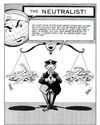試す 金 - 無料
The First Information Revolution
Reason magazine
|January 2026
PRINTING PRESSES AND LIBRARIANS INTERPRETED CENSORSHIP AS DAMAGE AND ROUTED AROUND IT.
IN THE NAME of the Rose, Umberto Eco describes a labyrinthine monastic library large enough to lose oneself in. The novelist didn't mention how many books filled its rooms, but John O. Ward of the University of Sydney worked out some straightforward calculations based on Eco's description of the layout and space. The collection, he concluded, would amount to 85,000 volumes.
The library was the "greatest in Christendom," Eco wrote. But actually, it was far, far bigger. It's not uncommon for a modern American public library to contain so many volumes, but no medieval library possessed that number—nowhere close.
Many early monastic libraries could fit their entire collections (probably just a couple of dozen codices) in a niche in the wall or in a single wooden box. As the centuries mounted, so did the stacks. Industrious monks added to the pile every year, but even then we're talking about relatively few volumes. In the sixth and seventh centuries, for instance, monks in the Latin West produced only around 120 books per year—in total. With such low output, libraries of massive size were unimaginable. In Anglo-Saxon Britain, for instance, they rarely exceeded 60 books.
Maybe we should expect small figures. This was, after all, before Charlemagne's education reforms. But if we jump to the Continent a bit later in the ninth century, as the reformers beavered away and book production climbed, inventory evidence for monastic libraries still underwhelms. Saint-Riquier sported just 256 books; St. Gallen, 264; Murbach, 315; and Reichenau, 415. Even the best libraries were poorly endowed. Lorsch shelved 590 books, and Bobbio, one of the most preeminent of all, housed 666. Perhaps an ominous number, but still far short of what Michel de Montaigne—a single individual, not an entire institution—eventually amassed on his own.
このストーリーは、Reason magazine の January 2026 版からのものです。
Magzter GOLD を購読すると、厳選された何千ものプレミアム記事や、10,000 以上の雑誌や新聞にアクセスできます。
すでに購読者ですか? サインイン
Reason magazine からのその他のストーリー

Reason magazine
A Nostalgic Read for Foreign Policy Elites
IF YOU WERE looking for a human avatar of America's unipolar moment, you couldn't do better than Michael McFaul. Picture a youthful, energetic McFaul with a newly minted Ph.D. bounding into the suddenly post-Soviet space of the early 1990s, full of bright ideas about democracy and faith in the end of history. As McFaul himself puts it, 1991 \"was a glorious moment to be a democratic, liberal, capitalist, multilateralist, and American....I was treated like a rockstar.\"
4 mins
January 2026

Reason magazine
TRUMP IS DEPORTING ENTREPRENEURS
THE TRUMP ADMINISTRATION'S MASS DEPORTATION EFFORT IS ROBBING THE U.S. OF IMMIGRANT BUSINESS OWNERS AND THEIR CONTRIBUTIONS.
9 mins
January 2026
Reason magazine
The First Information Revolution
PRINTING PRESSES AND LIBRARIANS INTERPRETED CENSORSHIP AS DAMAGE AND ROUTED AROUND IT.
11 mins
January 2026

Reason magazine
What Would Bill Buckley Do?
THE NATIONAL REVIEW FOUNDER'S FLEXIBLE APPROACH TO POLITICS DEFINED CONSERVATISM AS WE KNOW IT.
7 mins
January 2026

Reason magazine
MAHA Mandates Food Labels
BURDENSOME FOOD LABELING mandates were once the province of Democrats, who pushed for calorie count requirements on restaurant menus and insisted packaged food must feature warnings about genet- ically modified ingredients and trans fats. Now it's Republicans leading the charge- with equally foolish results.
2 mins
January 2026

Reason magazine
IS JAKE TAPPER DOOMED?
THE CNN ANCHOR ON THE WAR ON TERROR, THREATS TO FREE SPEECH, AND THE FUTURE OF MEDIA
14 mins
January 2026

Reason magazine
REPUBLICAN SOCIALISM
THE TRUMP ADMINISTRATION IS BUYING STAKES IN COMPANIES. THAT NEVER ENDS WELL.
13 mins
January 2026

Reason magazine
A Taste of Capitalism in Warsaw
WARSAW, POLAND, IS a living museum of economic systems. It's a city where concrete reliefs of stoic factory workers decorate a building that now houses a Kentucky Fried Chicken, where a Soviet-era apartment block stands beside a glass tower filled with coworking spaces.
2 mins
January 2026

Reason magazine
Robert Crumb's Roving Art and Life
IN THE SPRING of 1962, an 18-year-old Robert Crumb was beaned in the forehead by a solid glass ashtray. His mother, Bea, had hurled it at his father, Chuck, who ducked. Robert was bloodied and dazed, once again a silent and enraged witness to his family's chaos.”
5 mins
January 2026

Reason magazine
THE HOWARD ROARK OF COMICS
SPIDER-MAN CO-CREATOR STEVE DITKO WAS A GREAT EXAMPLE OF, AND DIRE WARNING TO, OBJECTIVIST POP ARTISTS.
12 mins
January 2026
Listen
Translate
Change font size

